|
FWC's TrophyCatch citizen-science program has just celebrated the incredible milestone of over 10,000 approved trophy bass weighing 8 lbs. and greater being caught, documented and released! If you enjoy bass fishing but have never participated in TrophyCatch, register now! Even if you don't get the opportunity to submit a trophy bass, registering shows our partners that you support Florida bass conservation! Signing up also automatically enters you in a drawing for a brand new Phoenix Boats bass boat package.
Here are some additional facts about this achievement:
- TrophyCatch has reached over 10,000 approved largemouth bass weighing 8 lbs. and greater for a total weight of 91,531 pounds!
- TrophyCatch has 85,600 participants that support Florida’s premiere conservation program. Register now to be included!
- The largest catch so far in 8 seasons was caught in 2017 by Dominic Montalto with a 16 lbs. 12 oz. bass caught in a neighborhood pond in Lee County, FL.
For the full story see this recent news release.
That’s just a glimpse as to why Florida is the Bass Fishing Capital of the World! This program would not be possible without our participants and the support of conservation partners like Bass Pro Shops and others!
Please join us in celebrating this huge milestone by posting your TrophyCatch anywhere on social media with the #TenThousandTrophies hashtag!
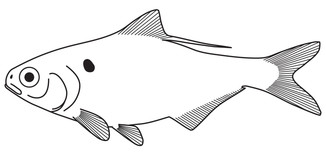
Size: The maximum it reaches is 9 inches, though it seldom exceeds 6 inches.
Identification and similar species: An extremely compressed (flat) fish with a distinct dark shoulder spot, long dorsal fin ray, and pointed snout. The body is bright silver, with a dark back. The scales are large in relation to the size of the fish and easily rub off.
|

The gizzard shad (left) is larger (to 20 inches), but young gizzard shad and adult threadfins are difficult to tell apart in the field, even by experienced anglers. The lower jaw of the gizzard shad does not protrude as far as that of the threadfin shad, although it takes a sharp eye to see the difference.
Angling qualities: This is an excellent bait for bass and snook, and even better for sunshine bass. However, the fish is itself seldom caught via hook-and-line. A castnet is the best collecting tool for filling the baitwell (see below).
Where to find them: These fish are found in open waters of lakes and ponds, and do not associate with vegetation or cover the way that most other fish do. Threadfin range throughout most of Florida, though do better and are more abundant in large, open lakes compared to smaller ponds or canals.
Interesting facts: Locating and catching threadfin shad can be more challenging than using them to catch bass. Shad can be sight-cast by watching the water’s surface for the telltale ripples made by a passing school. Another excellent way to locate shad is to look for birds feeding on them, or to spot bass “crashing” a school. (All these tips work for shiners as well.) From boat, a larger castnet is best for covering a wide area. From shore, a smaller net with an extra-long rope can be cast farther and more accurately to precisely target a spotted school. Shad travel in much higher numbers and more compact schools than golden shiners, and a single well-placed cast is often all that is needed to gather enough bait for a day’s fishing. However, shad are extremely sensitive and require a great deal more care than the hardier shiner. They have very high oxygen demands, so the baitwell must be well-aerated. A round livewell, or at least one with rounded corners, is particularly important for shad as they will swim around the baitwell continuously. Handle shad carefully to avoid rubbing off scales, and use only fine-wire hooks to minimize injury to the bait as well as to allow the fish to swim more freely.
|
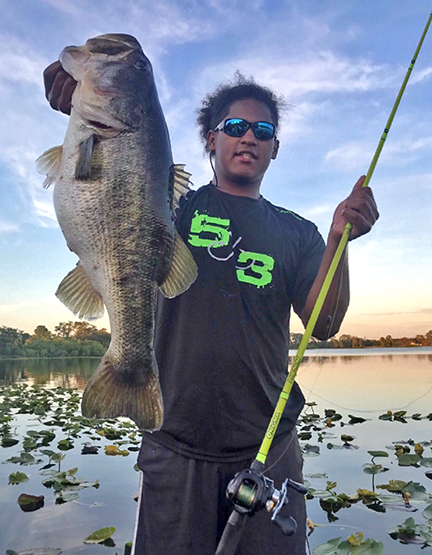 |
TrophyCatch program participant Syl Sims poses with his largest catch to date, a 13 lbs. 4 oz. bass caught and released in Lake Istokpoga. Is a new state record on the horizon?
That largemouth bass you’ve been battling with is now in your boat. It’s huge. Could it be the new state record? And if it is, how do you certify it?
The present state record for largemouth bass weighed 17.27 pounds and was caught by Billy O’Berry in Polk County in 1986. Although that record has stood over 30 years, recent submissions of giant 15- and 16-pound bass to FWC’s TrophyCatch citizen-science program has anglers and biologists alike asking when the next state record will show up.
This is what that lucky angler will need to know: To properly certify a new Florida state record, an FWC biologist must identify the fish species, and an FWC employee — usually the same individual — must witness its weighing on a certified scale. Anglers can check the current state records online at FWC's Big Catch angler recognition website.
Anglers should notify the nearest FWC regional office if they believe they have caught a record fish. Contact information for FWC regional offices can be found under the “Regional Operations” tab.
For additional information, see the recent state record news release.
Even on days when a favorite fishing buddy or family member can’t come along, a Florida angler never fishes alone. Our state is blessed with an amazing variety of wildlife, and birds are easily the most conspicuous examples. In fact, Florida is one of the best states for “birding” (as the sport is now called), and enthusiasts will travel hundreds of miles to observe our outstanding collection of species. Birding also shares at least two similarities with angling: You can get started in either sport with only a few pieces of basic equipment, and you can enjoy participating at any level from casual to avid. Birding is an excellent way to not only "double your pleasure" and enjoyment when fishing in the outdoors, but to increase your observational skills as well.
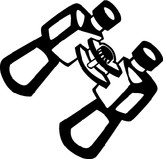
For the angler, equipment need be no more than a rod and reel and a handful of lures. For the birder, all that’s needed for literally years of enjoyment are a pair of binoculars and a bird identification guide. When choosing binoculars, you get what you pay for, and fortunately modern manufacturing technology provides an excellent bang for the buck. Most binoculars costing $40-50 or more will be adequate for the beginning or casual enthusiast. Binoculars are designated by two numbers, such as 7x35 (one of the most popular configurations). The first number is the magnification (7x). That means a distant bird or other object will appear 7 times closer. Don't succumb to the temptation to buy the most powerful binoculars you can find! Most people can hold binoculars up to about 7x or 8x steadily, but only more steady-handed observers should consider a 10x pair. Also note that the higher the power, the smaller the "field of view," or circle of visibility, through the binoculars. A small field of view covers less area and makes it harder to spot your target.
The second number is the size of the objective (front lens) in millimeters. The larger the number, the more light enters the binoculars and the brighter the image will remain at dawn or dusk, or under cloudy skies. However, larger lenses add weight and bulk. If you have the room to stow it in your truck or boat, a full-sized pair of 7x35 or 8x40 binoculars is great for all-around use. If space is at a premium, compact binoculars (usually with specifications close to 7x25 or 8x30) are small enough to fit in a glove compartment or tackle box. They do not provide as bright an image as larger-lensed binoculars, but even a pair of tiny compacts is far superior to having no binoculars at all.
|
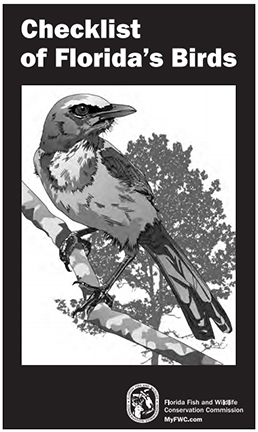
Selecting a first bird guide is a bit easier. Popular guides include Roger Tory Peterson’s A Field Guide to the Birds of Eastern and Central North America, National Audubon Society Field Guide to North American Birds: Eastern Region, The Sibley Field Guide to Birds of Eastern North America, and the National Geographic Field Guide to the Birds of North America, among others. Bird identification apps are also available, saving you the trouble of having to carry a book onto the boat or into the woods; see this National Audubon Society article for some suggestions. Things to pay attention to on a bird include its size, bill shape, coloration, and behavior. One of the handiest birding accessories is FWC's free Checklist of Florida Birds (right), which tells you which birds you can expect during which time of year, and helps you eliminate birds you might see in your field guide that are not found in Florida. Additional birding resources that are especially helpful to the beginner are also available at the FWC birding page, and the Great Florida Birding & Wildlife Trail website is a great interactive resource for finding good birding locations near you. Finally, FWC's Wings Over Florida program is one of the most fun ways to challenge yourself to see as many Florida bird species as possible!
Ready to identify some fellow fishing birds? The more common species illustrated below — some of Florida's iconic herons and egrets — are relatively easy. For this particular group, it is helpful to pay special attention to the general size of the bird, the color of the legs, and the color or shape of the bill. Good luck as you double your outdoors pleasure!
|
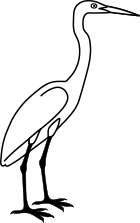 |
|
Great Egret — 32"; abundant. One of our most common and easily found waders. It is a large species with yellow bill and black legs. Sometimes seen feeding along roadsides or hedgerows. |
Snowy Egret — 20”; uncommon. A medium-sized heron with a thin black bill and black legs with yellow feet (referred to as “slippers”). Tinier and “daintier” than the great egret. This bird was once hunted to near extinction for its beautiful plumes, used at the time to decorate hats. |
|
 |
 |
|
Little Blue Heron (immature) — 22”; common. A medium-sized white heron with a bluish, black-tipped bill and bluish to greenish legs. As a juvenile matures, it will have more and more patches of blue on its body, until it becomes entirely dark. |
White Ibis — 22”; abundant. Medium-sized, with black wingtips and a distinct curved red bill. Juveniles are similar but mottled white and brown. This species is aquatic, but is also observed on fields, golf course fairways, or lawns. Unlike most waders, the white ibis may use its long bill to probe into the ground for food. |
|
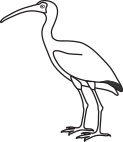 |
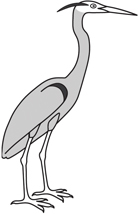 |
|
Great Blue Heron — 38”, common. Our only large, dark heron. Head is whitish, with the rest of the body various shades of blue-gray. Black head crest may also be visible. Feeds on the largest food items of any of our herons and has a particular preference for snakes! |
Little Blue Heron (adult) — 22”; common. A medium-sized bird with a bluish, black-tipped bill and a dark blue body and reddish neck and head. Appears to be a single, dark color from a distance. Compare with the tricolored heron, below. |
|
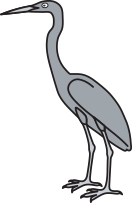 |
 |
|
Tricolored Heron — 22”; uncommon. Medium-sized, and very similar to the little blue heron above. Note, however, the white throat stripe and white undersides, as well as the yellow legs and white head crest. |
Glossy Ibis — 20”; uncommon. Entirely dark with a curved dark bill. Although it appears black at a distance, good light and a closer look reveal a glossy dark red bird with glossy green sides. |
|
 |
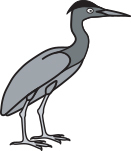 |
|
Green-Backed Heron — 14”; common. Our smallest dark heron. The green-backed has a shorter neck than other herons, and often keeps it coiled so that it is not visible, giving this bird a very “chunky” appearance. Also note the dark crest on the head and the short legs. Rather than wading directly in the water, this species is often seen perched on shoreline branches or walking on floating vegetation. More secretive than most other wading birds. |
To contact the Florida Freshwater Angler, email John Cimbaro.
|